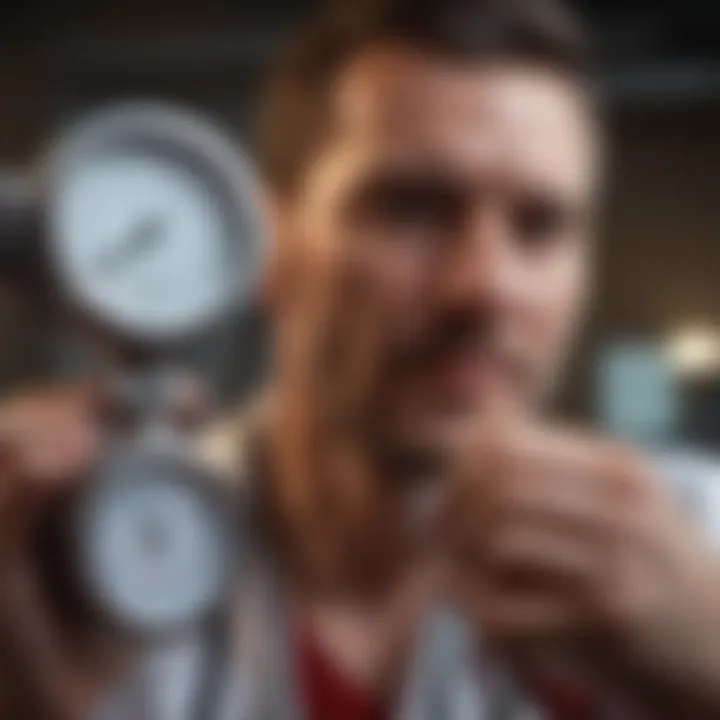Effective Nurse Strategies for Hypertension Management


Intro
Hypertension, often called the silent killer, is a prevalent condition affecting millions globally. The role of nurses in managing this condition is essential, particularly regarding patient education. Nurses are often the primary health professionals who interact with patients, guiding them through the complexities of hypertension management. Effective nurse teaching strategies can significantly improve patient outcomes, and therefore, these strategies deserve thorough examination.
In this article, we delve into various aspects of hypertension management from a nursing perspective. We will explore core concepts, teaching methods, and future directions in research. Understanding the pathophysiology of hypertension, recognizing risk factors, and emphasizing lifestyle modifications are critical teaching points. Moreover, nurses can enhance patient comprehension and adherence through innovative teaching methods, leading to better management of hypertension.
Through a systematic approach, this article aims to equip nursing professionals with the knowledge and skills needed to engage and educate patients effectively. \n
Key Concepts
Definition of Primary Terms
Understanding hypertension requires clarity on certain terms.
- Hypertension: A condition characterized by persistently elevated blood pressure, specifically when readings exceed 130/80 mmHg according to recent guidelines.
- Patient Engagement: The involvement of patients in their own health care, encompassing awareness, motivation, and self-management.
- Lifestyle Modifications: Lifestyle changes that can effectively lower blood pressure, including dietary changes, physical activity, and stress reduction.
Related Concepts and Theories
Several theories underpin effective teaching strategies in nursing.
- Andragogy: This principle emphasizes the unique needs of adult learners, recognizing that adults bring experiences and knowledge that influence their learning.
- Health Belief Model: This model posits that health behaviors are influenced by perceived risks and benefits, which can guide how nurses frame their educational content.
- Transtheoretical Model: This model describes stages of change—precontemplation, contemplation, preparation, action, and maintenance—that can help nurses tailor their approach according to patient readiness.
"Effective education is not just about transmitting information, but also about empowering patients to take control of their health."
Future Directions
Gaps Identified in Current Research
There are various gaps in hypertension education research that warrant further exploration. Many studies focus primarily on clinical outcomes but do not sufficiently address educational interventions or patient perspectives. This lack of qualitative data may hinder the development of more effective strategies tailored specifically for diverse patient groups.
Suggestions for Further Studies
Future research should focus on:
- Exploring Personalized Teaching Methods: Investigate how individualized teaching can affect patient adherence and understanding.
- Evaluating Technology Integration: Assess how telehealth and mobile health applications can enhance hypertension management education.
- Longitudinal Studies on Patient Outcomes: Conduct studies that follow patients over time to understand the long-term impact of educational strategies on hypertension management.
Preface to Hypertension
Hypertension is a critical health issue that affects a significant portion of the global population. Understanding hypertension is indispensable for nurses and healthcare professionals, as it lays the groundwork for effective patient management and education. It is not merely a condition of elevated blood pressure but a risk factor for a variety of severe health problems, including heart disease and stroke. By grasping the nuances surrounding hypertension, nurses can provide more tailored care and enhance patient outcomes.
Good hypertension management starts with a solid foundation of knowledge. This article aims to guide nurses in identifying teaching strategies, recognizing patient needs, and fostering engagement. The integration of educational practices into patient care can lead to better health behaviors among individuals suffering from this condition.
Definition and Statistics
Hypertension, often referred to as high blood pressure, is defined by the American Heart Association as a condition where the blood pressure readings surpass 130 mmHg systolic or 80 mmHg diastolic. This condition can be classified as either primary (essential) hypertension, which has no clear cause, or secondary hypertension, which is attributable to underlying medical issues such as kidney disease or hormonal imbalances.
Recent statistics indicate that nearly 1.13 billion people worldwide are living with hypertension, indicating a widespread health concern. In the United States, it is estimated that about 45% of adults have high blood pressure. Such figures emphasize the necessity for comprehensive hypertension education among healthcare professionals, particularly nurses.
Global Impact of Hypertension
The global implications of hypertension are profound. This condition not only affects individual health outcomes but also poses significant economic burdens on healthcare systems. Countries with established healthcare infrastructures face challenges coping with the prevalence of hypertension, significantly impacting public health resources.
Hypertension is a leading cause of premature death worldwide, contributing to significant healthcare costs. Its management requires a multifaceted approach that considers the individual needs of patients. Education strategies by nurses play a vital role in addressing this health issue. By fostering awareness and providing treatment information, nurses can help mitigate the impact of hypertension on overall community health, contributing to healthier populations globally.
Understanding Hypertension
Understanding hypertension is fundamentally important in the management of this prevalent cardiovascular condition. It involves grasping the underlying mechanisms, types, and risk factors associated with hypertension. This understanding is crucial for nurses, as they play a pivotal role in educating patients and tailoring management strategies to improve outcomes.
Hypertension, often termed the "silent killer," can lead to serious complications like heart disease, stroke, and kidney failure. Therefore, a comprehensive knowledge of how hypertension develops and manifests can significantly enhance patient care. Nurses equipped with a solid understanding of this disorder can more effectively educate patients about prevention and management strategies. They can help individuals recognize their own risk factors and the importance of lifestyle modifications, which can lead to better health outcomes.
In addition, understanding hypertension supports the implementation of evidence-based practices. Nurses can leverage their knowledge to engage patients in meaningful conversations about their health. Through education, patients become active participants in their care. The benefits of this engagement are numerous, ranging from improved adherence to prescribed therapies to lifestyle changes that can prevent the progression of hypertension. Overall, a strong grasp of hypertension serves as the foundation for effective nursing interventions and patient education.
Pathophysiology of Hypertension
The pathophysiology of hypertension involves complex interactions between genetic, environmental, and physiological factors. Hypertension occurs when the force of blood against the artery walls is consistently too high. This can arise due to increased cardiac output or increased vascular resistance, often resulting from structural or functional changes in the blood vessels.
When the arteries cannot accommodate the blood volume effectively, it leads to high blood pressure. Factors such as renin-angiotensin-aldosterone system (RAAS) activation, sympathetic nervous system overactivity, and changes in the elasticity of blood vessels play critical roles in this pathophysiological process. Understanding these mechanisms is essential for nurses as it informs the assessment and management of hypertensive patients.
Types of Hypertension
Primary Hypertension
Primary hypertension, also known as essential hypertension, accounts for about 90-95% of all cases. This type of hypertension does not have a specific identifiable cause and generally develops gradually over many years. Primary hypertension is characterized by persistent elevation of blood pressure readings, which can result from a combination of genetic predispositions and lifestyle factors.
The unique feature of primary hypertension is its multifactorial origin, encompassing diet, physical activity, and stress levels. This complexity makes primary hypertension a common discussion point in hypertension management.
Addressing primary hypertension typically involves lifestyle modifications such as diet, exercise, and weight management. Those strategies can lead to significant improvements in patient outcomes. Thus, primary hypertension serves as a beneficial and prevalent focus for education within this article.
Secondary Hypertension


Secondary hypertension is often a result of an underlying condition, such as kidney disease, hormonal disorders, or medications. Unlike primary hypertension, secondary hypertension has a clear, identifiable cause, which can make management more straightforward.
One key aspect of secondary hypertension is its potential reversibility. By treating the primary cause, such as controlling renovascular conditions or adjusting medications, blood pressure can be effectively managed or normalized. This trait gives secondary hypertension a unique place in hypertension education and management.
Though secondary hypertension may appear to be advantageous for nursing interventions due to its potential for resolution, it is essential for nurses to remember that timely identification and management of the underlying conditions are crucial to prevent complications.
Understanding both types of hypertension is vital for developing effective patient education strategies. It empowers nurses to tailor interventions that address individual patient needs.
Risk Factors for Hypertension
Understanding risk factors for hypertension is crucial for nurses engaging in patient education. Hypertension is influenced by a variety of factors that can be modified and some that cannot. Addressing risk factors not only aids in prevention but also enhances patient care by equipping individuals with knowledge to mitigate their risks.
Modifiable Risk Factors
Modifiable risk factors are lifestyle habits and choices that individuals can change or influence, which can significantly reduce the likelihood of developing hypertension.
Obesity
Obesity is a key player in contributing to hypertension. It is characterized by an excess body fat that can lead to various health issues, including elevated blood pressure. The importance of targeting obesity is backed by research showing its direct correlation with hypertension prevalence. Individuals who are obese may experience increased vascular resistance and arterial stiffness, which can raise blood pressure levels.
Obesity is often viewed as a primary target for intervention due to its modifiable nature. Encouraging weight loss through diet and exercise can lead to significant improvements in hypertension outcomes. The unique feature of obesity is its multifaceted relationship with diet, physical activity, and metabolism. The advantages of addressing obesity in hypertension management include potential reductions in medication reliance and improvement in overall health metrics.
Physical Inactivity
Physical inactivity is another significant risk factor for hypertension. This condition is linked to a sedentary lifestyle, where minimal physical activity leads to weight gain and weak cardiovascular health. Addressing physical inactivity is critical as regular exercise proves to be effective in lowering blood pressure and improving heart health.
Nurses can play a vital role by encouraging patients to engage in physical activities tailored to their abilities. The key characteristic of physical inactivity is its widespread impact on various demographic groups. Promoting exercise not only aids in weight management but also improves mood and overall quality of life. The challenge remains in motivating patients to adopt a more active lifestyle, but the benefits are clear in reducing hypertension risks.
High Sodium Intake
High sodium intake remains a major modifiable risk factor linked to hypertension. Sodium consumption is prevalent in modern diets, often exceeding recommended levels. Excessive sodium intake can lead to fluid retention, increasing blood pressure. Nurses should educate patients about the risks associated with consuming too much salt and encourage them to adopt a sodium-reduced diet.
The educational aspect of addressing high sodium intake involves teaching patients how to read food labels and recognize hidden sodium in processed foods. The unique feature of this risk factor is its manageable nature through dietary adjustments. The advantages of reducing sodium intake include not only lower blood pressure but also improved heart health over the long term.
Non-modifiable Risk Factors
Non-modifiable risk factors are those that individuals cannot change but must be understood for effective hypertension management. They play a crucial role in patient education and risk assessment.
Age
Age is a significant non-modifiable risk factor for hypertension. As individuals age, the blood vessels tend to stiffen, leading to increased blood pressure risks. This characteristic of age underscores the importance of regular blood pressure checks, especially in older adults. Understanding this risk factor helps nurses focus on monitoring and timely interventions.
The unique feature of age is its progression across the lifespan, making older adults more susceptible to hypertension. While this factor cannot be changed, increasing awareness about healthy lifestyle choices in aging populations can mitigate other risks associated with hypertension.
Genetics
Genetic predisposition to hypertension is another non-modifiable risk factor. Family history plays a vital role in an individual's risk level. Genetic factors influence how the body regulates blood pressure and can predispose individuals to hypertension.
Highlighting genetics in hypertension management allows healthcare professionals to understand the background of their patients deeply. While genetics cannot be modified, knowledge can empower patients to make informed lifestyle choices based on their family histories. The advantage lies in recognizing the inherited risk, enabling earlier prevention strategies and consistent monitoring of blood pressure.
"Being aware of both modifiable and non-modifiable risk factors is essential for effective hypertension management."
Overall, comprehensively understanding risk factors for hypertension enables nurses to provide better education and counseling, ultimately improving patient outcomes.
The Role of Nurses in Hypertension Management
Hypertension presents a significant public health challenge, requiring dedicated nursing practice to effectively manage it. Nurses are at the forefront of patient care, making their role crucial in hypertension management. Their responsibilities cover a wide range of functions, from patient education to collaboration with healthcare teams, which all contribute to bettering patient outcomes. Additionally, they act as advocates for patients, ensuring that those suffering from hypertension receive the necessary support and resources.
Through proper management of hypertension, nurses help prevent associated complications such as heart disease and stroke. They are equipped to monitor patient health, recognize signs of worsening conditions, and provide timely interventions. Establishing a therapeutic relationship is another critical aspect. This relationship allows nurses to tailor education and interventions to fit the individual needs of patients, leading to increased adherence to treatment plans.
Moreover, nurses must understand diverse populations and their unique needs related to hypertension. Cultural competence in nursing enhances communication and education, fostering trust. Understanding factors such as socioeconomic status and health literacy can significantly influence a patient's ability to manage their hypertension effectively.
The involvement of nurses extends beyond direct patient care. They also participate in healthcare policy development and advocacy concerning hypertension awareness and management. By promoting community health initiatives, nurses contribute to broader strategies aimed at reducing the prevalence of hypertension in various populations.
Studies show that nurse-led educational programs significantly improve patient understanding and management of hypertension.
Overall, the role of nurses in hypertension management encapsulates both clinical practice and community outreach, illustrating their multifaceted responsibilities in this critical area of healthcare.
Patient Education and Engagement
Patient education is a fundamental component of nursing practice in hypertension management. It involves the transfer of relevant information to patients, enabling them to make informed decisions regarding their health. Effective education not only enhances knowledge but also empowers patients to engage actively in their own care. This empowerment can lead to significant improvements in adherence to treatment and lifestyle modifications.
Engagement strategies may include personalized education sessions, emphasizing understanding rather than rote memorization. For instance, explaining the significance of blood pressure readings or what factors contribute to elevation can create a more relatable context for patients. Role-playing or motivational interviewing may also be utilized.
It's vital to assess the patient’s current knowledge and tailor education accordingly. This method ensures that information delivery aligns with the patient’s learning style, whether they prefer visual, auditory, or kinesthetic learning methods.
Collaborative Care Approach
The collaborative care approach highlights the importance of teamwork in managing hypertension effectively. Nurses work closely with doctors, dietitians, and other healthcare professionals to create a cohesive treatment plan. This multiprofessional collaboration facilitates comprehensive care, addressing all dimensions of a patient's health.
Nurses often act as the liaison between patients and the rest of the healthcare team, ensuring that patient concerns are communicated effectively. Regular interdisciplinary meetings may help in reviewing patient progress, adjusting treatment plans, and setting realistic health goals.


Moreover, involving patients in these discussions fosters a sense of ownership over their health. Patients are more likely to engage in their care when they feel their opinions are valued. This approach leads to better compliance with treatment recommendations and ultimately improves health outcomes.
Teaching Strategies for Hypertension Education
The landscape of hypertension management is ever-evolving. Nurses play a pivotal role in facilitating patient education. Effective teaching strategies enable nurses to convey crucial information to patients, ultimately contributing to better management of hypertension. This section focuses on two key components of nursing education: assessing patient learning needs and utilizing evidence-based teaching methods. Each element interacts to create a comprehensive educational approach that enhances patient engagement and compliance.
Assessing Patient Learning Needs
Understanding a patient's learning needs is essential for tailoring educational interventions. Nurses must take the time to assess factors such as a patient's current knowledge, readiness to learn, and preferred learning styles. This assessment helps nurses to design a personalized learning plan that addresses specific gaps in knowledge.
Several tools and methods can assist with this assessment:
- Patient Interviews: Conducting interviews helps gauge the patient’s understanding and concerns regarding hypertension.
- Surveys and Questionnaires: These can be used to measure knowledge levels and identify areas needing further explanation.
- Observational Techniques: Observing patient behaviors can provide insight into how well they understand their condition and treatment.
By effectively assessing learning needs, nurses can deliver information that is relevant and digestible.
Utilizing Evidence-based Teaching Methods
Implementing evidence-based teaching methods ensures that patient education is grounded in the latest research and practices. This approach increases the likelihood that patients will retain information and apply it effectively. Two notable teaching methods include interactive learning and visual aids.
Interactive Learning
Interactive learning is characterized by participant engagement in the learning process. Nurses can employ various interactive techniques, such as role-playing or group discussions, which encourage patient involvement and feedback. The key characteristic of this method is its ability to foster a deeper understanding through discussion and practical application. This engagement stimulates critical thinking and allows patients to ask questions in real-time.
The unique feature of interactive learning is its adaptability. Nurses can customize the learning experience based on individual patient needs and responses, leading to more effective education. However, one disadvantage might be that some patients may feel intimidated by active participation, especially in group settings.
Visual Aids
Visual aids play a significant role in hypertension education. These may include charts, diagrams, and videos that illustrate complex concepts in a straightforward manner. The key characteristic of visual aids is their ability to enhance comprehension by presenting information in a digestible form. They serve as a powerful tool for patients who may struggle with textual explanations.
A distinct advantage of visual aids is that they can cater to diverse learning styles. Patients who are visual learners benefit greatly from this method. One challenge, however, is ensuring that visual aids are culturally relevant and not overly complex, which could lead to confusion rather than clarity.
Lifestyle Modifications for Hypertension Prevention
Effective management of hypertension often hinges on lifestyle modifications. These changes can significantly lower blood pressure and enhance overall cardiovascular health. Nurses play a pivotal role in guiding patients through these adaptations, helping them understand the practical steps involved. This section will discuss dietary changes and exercise recommendations as primary strategies for hypertension prevention.
Dietary Changes
Diet is a cornerstone of hypertension management. It greatly influences blood pressure levels and general well-being. Nurses can educate patients on specific dietary approaches, notably the DASH diet and the importance of sodium reduction. Each of these strategies carries its own unique benefits and considerations for patients.
DASH Diet
The DASH diet, which stands for Dietary Approaches to Stop Hypertension, is designed specifically to combat high blood pressure. This diet focuses on incorporating fruits, vegetables, whole grains, and lean proteins while minimizing saturated fat and cholesterol. One key characteristic of the DASH diet is its emphasis on nutrient-rich foods. These options are not only heart-friendly but also promote a balanced intake of vitamins and minerals.
One notable feature of the DASH diet is its overall flexibility, making it a viable option for diverse lifestyles. It encourages the intake of potassium, calcium, and magnesium, which are crucial in managing blood pressure effectively. The advantages of this approach include not only hypertension reduction but also potential weight loss, leading to further improvement in blood pressure levels. On the other hand, some may find the initial transition challenging as it often means leaving behind their usual dietary patterns.
Sodium Reduction
Sodium reduction is another crucial dietary strategy. High sodium intake is closely linked to elevated blood pressure levels. Nurses can stress the importance of reading food labels to monitor sodium content, highlighting that many processed foods contribute significantly to daily intake. A key characteristic of sodium reduction is its straightforward implementation; reducing processed and ready-to-eat foods can substantially decrease sodium consumption.
The unique feature of sodium reduction lies in its immediate effects on blood pressure. A reduction of sodium intake can lead to noticeable improvements in hypertension management. Moreover, many patients experience other health benefits, such as weight loss and improved kidney function. However, it is essential to consider that overly restrictive approaches may lead to frustration, which could deter long-term adherence.
Exercise Recommendations
Physical activity also plays a vital role in managing hypertension. Regular exercise helps reduce blood pressure, improve overall heart health, and supports weight management. Nurses can provide recommendations tailored to each patient's abilities and preferences. Engaging in 150 minutes of moderate aerobic activity each week significantly enhances cardiovascular fitness and contributes to long-term hypertension management. Emphasizing activities such as brisk walking, cycling, or swimming can motivate patients towards a healthier lifestyle.
"Lifestyle modifications, including dietary changes and exercise, can serve as effective strategies in managing hypertension. These alterations not only benefit blood pressure but promote overall health as well."
Medication Management in Hypertension
Medication management in hypertension is critical for maintaining optimal blood pressure levels and reducing the risk of complications. It requires a thorough understanding of various antihypertensive medications, including their benefits and potential side effects. The choice of medication often depends on individual patient profiles, which emphasizes the necessity of personalized care in nursing practice. This approach not only enhances therapeutic effectiveness but also supports patient adherence by aligning treatment with their specific needs and preferences.
Types of Antihypertensive Medications
ACE Inhibitors
ACE Inhibitors are pivotal in the management of hypertension. They work by inhibiting the angiotensin-converting enzyme, leading to vasodilation, reduced blood pressure, and decreased cardiac workload. A key characteristic of ACE Inhibitors is their ability to promote renal health by lowering intraglomerular pressure, which is particularly beneficial for patients with diabetes or chronic kidney disease.
These medications, such as Lisinopril and Enalapril, are popular due to their cardiovascular protective effects. A unique feature of ACE Inhibitors is their impact on the metabolic profile, as they do not typically cause significant weight gain or affect glucose metabolism. However, their use can be complicated by side effects like cough or angioedema, necessitating careful patient monitoring and education.
Beta-Blockers
Beta-Blockers are another cornerstone in hypertensive therapy. They primarily function by blocking the effects of adrenaline on beta-adrenergic receptors, leading to a reduction in heart rate and contractility, which ultimately lowers blood pressure. A noteworthy characteristic of Beta-Blockers is their effectiveness in managing comorbid conditions like anxiety and heart failure, making them a versatile choice in clinical practice.
Medications such as Metoprolol and Atenolol highlight the advantages of Beta-Blockers with their consistent blood pressure-lowering effects. However, one should consider their unique disadvantage of potentially causing fatigue or diminished exercise tolerance, which may impact adherence, especially in active patients. Therefore, education on these aspects is crucial.
Patient Education on Medication Adherence
Effective patient education on medication adherence is imperative for the success of antihypertensive treatment. Nurses play a vital role in creating individualized medication plans and ensuring patients understand the importance of following these regimens. This involves clear communication about the purpose of each medication, how it functions to lower blood pressure, and potential side effects.
Engaging patients through various teaching strategies can significantly enhance their understanding and retention of information. Utilizing visual aids, providing written resources, and encouraging questions fosters a supportive environment that promotes adherence. Regular follow-up and reassessment of patients' knowledge and attitudes towards their medications can also identify barriers to adherence and provide opportunities for targeted interventions.


"Educated patients are empowered patients. In hypertension management, knowledge is an essential component for adherence and better health outcomes."
In summary, thorough knowledge of antihypertensive medications and effective patient education strategies are essential components of successful hypertension management practices for nurses.
Evaluation of Teaching Effectiveness
Evaluation of teaching effectiveness is a crucial element in enhancing nursing practices related to hypertension management. It provides a framework for assessing whether the educational strategies employed by nurses achieve the desired outcomes. Through effective evaluation, nurses can adapt their teaching methods, ensuring that they meet the individual needs of patients experiencing hypertension.
Importance of Evaluation
Understanding the evaluation of teaching effectiveness allows for identifying successful educational interventions. It leads to improved patient knowledge, behavior changes, and ultimately better health outcomes. Evaluation can also highlight areas requiring additional focus or refinement, ensuring that educational goals align with patient needs.
Specific Elements of Evaluation
- Assessment Tools: Various tools, such as surveys or quizzes, can assess patient comprehension and retention of information.
- Observation: Nurses can directly observe patient reactions and engagement during education sessions. This can provide insights into the effectiveness of different approaches.
- Patient Feedback: Collecting patient feedback is essential. It provides qualitative data on patients' perceptions of the educational materials and teaching methods.
Benefits of Evaluation
- Enhanced Learning: Acknowledging what works well can reinforce effective strategies while refining inadequate ones.
- Informed Decision-Making: Evaluations guide nurses in making data-driven decisions regarding their teaching strategies.
- Patient-Centered Care: Adaptations based on evaluation results ensure education is relevant and tailored to the patients’ preferences and understanding.
Considerations about Evaluation
When implementing evaluations, nurses must consider the diverse backgrounds, literacy levels, and health literacy of their patients. Adjusting the evaluation methods accordingly is essential to gather accurate data that reflects the effectiveness of teaching.
"The unexpected variations in patient comprehension highlight that a one-size-fits-all model does not exist; evaluation must mold itself to the individual characteristics of each patient."
In summary, evaluation serves as a mechanism to measure teaching effectiveness. It plays a vital role in improving the educational strategies used by nurses in managing hypertension. Understanding its components and benefits is necessary for advancing patient education initiatives, ultimately enhancing health outcomes.
Feedback Mechanisms
Feedback mechanisms are essential in the context of evaluating educational effectiveness. They provide researchers and educators with the insights necessary to refine and improve their strategies. A structured feedback process may involve a variety of methods, each contributing to a comprehensive understanding of patient education outcomes.
- Surveys and Questionnaires: These can be distributed post-education to capture immediate reactions and reflections.
- Focus Groups: Engaging patients in group discussions can gauge perceptions and gather qualitative feedback on the teaching process.
- One-on-One Interviews: These allow for deeper insights through personalized discussions about the education received.
Feedback mechanisms encourage open communication. They empower patients to express their views and facilitate iterative improvement of educational content and delivery methods.
Measuring Patient Outcomes
Measuring patient outcomes is a key aspect of evaluating teaching effectiveness in hypertension education. It involves assessing changes in patient behavior, knowledge retention, and health status after educational interventions.
- Pre- and Post-Education Assessments: Conducting assessments before and after education can show knowledge gains and behavior changes.
- Clinical Outcomes: Monitoring changes in blood pressure levels can demonstrate the direct impact of education on patient health.
- Long-Term Follow-Up: Scheduled check-ups can assess the sustainability of behavior changes over time.
Each of these methods contributes to a thorough understanding of how effective teaching translates to real-world health improvements. A robust measurement strategy ensures that interventions continuously evolve toward better educational outcomes for patients managing hypertension.
Barriers to Effective Hypertension Education
Understanding the barriers to effective hypertension education is crucial for improving patient outcomes. Without recognizing these obstacles, nurses may struggle to convey essential information, ultimately affecting patients' ability to manage their condition effectively. Addressing these barriers allows healthcare providers to enhance educational approaches and optimize patient engagement.
Patient-Centric Barriers
Patient-centric barriers can severely limit the effectiveness of educational strategies. These barriers often stem from individual patient characteristics that can hinder their understanding or application of the information provided. Some factors include:
- Low health literacy: Many patients may not fully comprehend medical terminology or concepts. This can lead to misunderstandings about hypertension management.
- Cultural differences: Variations in beliefs, language, and practices can influence how patients perceive health information. A lack of culturally tailored resources may alienate some patients, making education less effective.
- Emotional barriers: Anxiety or fear about their condition may impede patients' ability to absorb educational content. An overwhelmed patient might retreat from discussions about their health.
Recognizing these factors is vital. Nurses can create educational materials that are simple, relatable, and culturally appropriate. Building trusting relationships helps patients feel comfortable discussing their concerns.
Systemic Barriers
Systemic barriers also impact effective hypertension education. These are constraints arising from the healthcare system itself, which can limit resources and support for both patients and healthcare providers. Significant systemic barriers include:
- Limited access to healthcare resources: Not all patients have easy access to healthcare professionals or education programs, particularly in rural or underserved areas.
- Time constraints during appointments: Nurses often face tight schedules, leaving little time for in-depth patient education. This hurried interaction can lead to incomplete understanding for patients.
- Inadequate training for healthcare providers: Some nurses may lack training in effective communication techniques relevant to educating patients about complex health issues like hypertension.
Addressing these systemic barriers is essential. Healthcare institutions can prioritize patient education by allocating adequate resources for nurse training and creating flexible scheduling options for patient appointments. This way, both patients and nurses can collaborate more effectively.
"Recognizing and addressing barriers to hypertension education is pivotal in enhancing patient understanding and management of their condition."
Future Directions in Hypertension Education
Hypertension education faces constant evolution. The integration of technology into healthcare settings represents a key direction. As hypertension management continues to be a significant health concern, attention to the latest teaching strategies is critical. It is vital for healthcare providers, especially nurses, to adapt to these changes. Improved patient outcomes often result from innovative educational approaches that leverage technology.
The Role of Technology
Technology is reshaping many fields, and healthcare is no exception. In the context of hypertension education, several tools are emerging. For instance, mobile health apps allow patients to track their blood pressure and medication schedules. These apps can facilitate reminders for medication intake and appointments. They also promote patient self-monitoring.
Another significant technological advancement involves telehealth. This approach enables nurses to conduct virtual consultations with patients. Such interactions can be beneficial in providing education and support without the need for in-person visits. This is particularly useful for patients living in remote areas or those with mobility issues. Furthermore, educational resources can be disseminated more broadly through online platforms, providing easy access to information.
Trends in Patient Education Approaches
As healthcare evolves, patient education strategies also change. One prominent trend is the emphasis on personalized education plans. Nurses are increasingly focusing on tailoring information to individual patient needs. This could include discussing specific dietary recommendations based on a patient's lifestyle or providing targeted exercise advice.
Moreover, integrating group education sessions is also gaining traction. These sessions allow patients to share experiences and strategies for managing hypertension. This peer-support can enhance motivation and adherence to treatment plans.
"Education is not just about delivering information; it is about creating a supportive environment where patients feel empowered to make changes."
Lastly, simulations and role-playing scenarios have found their place in hypertension education. These methods help patients grasp complex topics while feeling more prepared for real-life situations.
Utilizing these modern educational tools and strategies will significantly impact how nurses manage hypertension education. The ultimate goal remains improving patient engagement and health outcomes.



